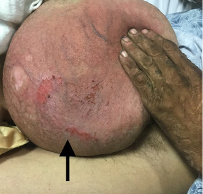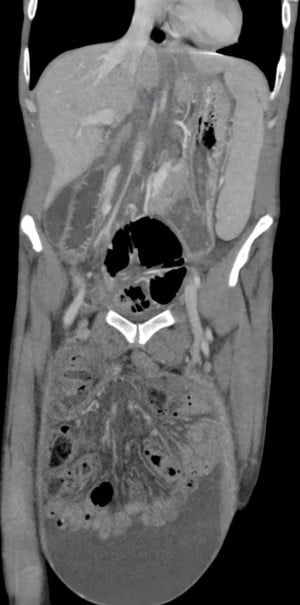Hernias with loss of domain are often a consequence of poor access to surgical care and require extensive planning and management. Emergency medicine and general surgery communities should collaborate on what constitutes a need for urgent surgical intervention or the need for surgical coordination without primary care acting as an additional step/obstacle.
Case
A 52-year-old male with a history of intravenous drug use, schizophrenia, Human Immunodeficiency Virus, and Hepatitis C presented for his fifth visit to our ED for scrotal pain. The patient denied dysuria, urinary frequency, flank pain, or fevers. His vital signs were within normal limits. Physical exam was remarkable for a significant scrotal hernia, approximately 49 cm in diameter, with auscultation of bowel sounds within scrotum and non-purulent tender excoriations at the inferior aspect. (Image 1).

Image 1: 52-year-old male with large scrotal hernia with excoriations (arrow).
Urinalysis, BNP, CBC, and CMP were unremarkable. Contrast CT of the abdomen and pelvis demonstrated massive right lower inguinal hernia involving several loops of bowel gas and fat with stranding. No free air or obstruction were appreciated, but mild free fluid was noted. (Image 2).

Image 2: CT of the abdomen and pelvis with IV contrast demonstrating large scrotal hernia and free fluid
General surgery was consulted and concluded no emergent surgical intervention was warranted. Patient was instructed to follow up with his primary care provider for outpatient surgery clinic referral as had been done several times previously.
Discussion
Unfortunately, loss of domain (LOD) hernias lack an exact definition without a validated metric for severity or prognosis. However, it is widely accepted that earlier interventions decrease long term sequela. Our patient suffered from multiple risk factors associated with health care disparity, including homelessness, HIV, and schizophrenia. Early intervention for such cases would mutually benefit the patient and provider despite it being non-emergent. Our case demonstrates the need for both emergency medicine and general surgery communities to reevaluate what constitutes an urgent surgical intervention and address the systematic barriers to prompt consultation and/or referral.
Early intervention and prompt referral offers readily apparent benefits such as decreased morbidity and mortality as guided by risk stratification and pre-operative assessment. As our patient is immunocompromised, more pre-emptive management could lead to a reduction of catastrophic infections such as necrotizing fasciitis and sepsis. Additional benefits may include less unnecessary imaging, reduction in cost (especially in cases of high health care utilization), and reduction of radiation exposure. Our patient's socioeconomic status further complicates his management, risk for postoperative complications, and ability to properly rehabilitate.
The benefit to the emergency physician is simple. Because frequent health care utilizers typically undergo multiple and repeat work-ups, their care leads to increased costs, decreased departmental efficiency, and increased risk for anchoring bias. The situation is further complicated by the fact that reproductive organ injuries are commonly litigated yet cannot be ruled out without extensive evaluations. Earlier intervention and well-coordinated follow-up from the ED could decrease the risk of bad outcomes for these types of patients.
The hospital itself would be well-served to create a system to catch the patients "falling through the cracks" or getting lost to follow-up. Decreasing the risk of needless litigation is an easy start, but also the preservation of medical assets to include money can be easily illustrated. For instance, it is not uncommon for hospitals to fail to recuperate expenses when caring for low socioeconomic, high utilizing, and significantly comorbid patients. The continuous cycle of costly work-ups and non-definitive intervention leads to financial losses for the hospital. The chart below using figures from "Healthcare Bluebook" shows a rudimentary cost of this patient's visits to the ED.
|
Intervention |
Low Range |
Fair Price |
High Range |
|
ED visit – complex problem |
$1377 |
$1720 |
$4301 |
|
Abdomen and pelvic CT with and without |
$338 |
$992 |
$6181 |
|
Testicular ultrasound |
$99 |
$147 |
$473 |
|
Total of each ED visit |
$1814 |
$2859 |
$10,955 |
|
Hernia repair (inguinal, umbilical, or ventral) |
$3526 |
$4407 |
$11,018 |
This estimated cost of each visit to the ED is between $1,814 - $10,995 using this source and a fair cost of $2859. The estimated total cost for our patient would be between $9,070 -$54,775. While the complexity of medical billing makes it impossible to know the exact total costs, it's reasonable to expect these to be much higher than the overall expense of a curative intervention. It is also important to note these costs do not account for any visits to other hospitals in the area.
While LOD hernias are well-known in the surgical community, they pose a unique challenge. They occur more frequently in rural and underserved populations, where patients are at higher risk for mental health issues, drug abuse, and poor access to care. These patients are generally worse surgical candidates and have higher risk of poor wound healing and hernia recurrence.2,3 Understandably, general surgeons hesitate to pursue overtly aggressive management.
Conclusion
After general surgery evaluation, our patient was determined to be a poor surgical candidate due to tobacco use, active IV drug abuse, and poor ability to follow-up.
While our patient's issues are complex, we feel the progression of his LOD hernia ultimately resulted from allowing a "failure of follow-up" cycle to continue, with each presentation being worse than the previous. While admittedly it may have been too late for our patient to receive surgical correction, our case demonstrates a large failure in our current system and an issue worth addressing.
References
-
Healthcare Bluebook. 2020. Retrieved from: https://www.healthcarebluebook.com/
-
Qaja E, Le C, Benedicto R. Repair of giant inguinoscrotal hernia with loss of domain. J Surg Case Rep. 2017;2017(11):rjx221.
-
Coetzee E, Price C, Boutall A. Simple repair of a giant inguinoscrotal hernia. Int J Surg Case Rep. 2011;2(3):32–35
-
Townsend CM, Beauchamp RD, Evers BM, Mattox K. Sabiston Textbook of Surgery: The Biological Basis of Modern Surgical Practice. Chapter 44: Hernias Elsevier - Health Sciences Division; 2016.



